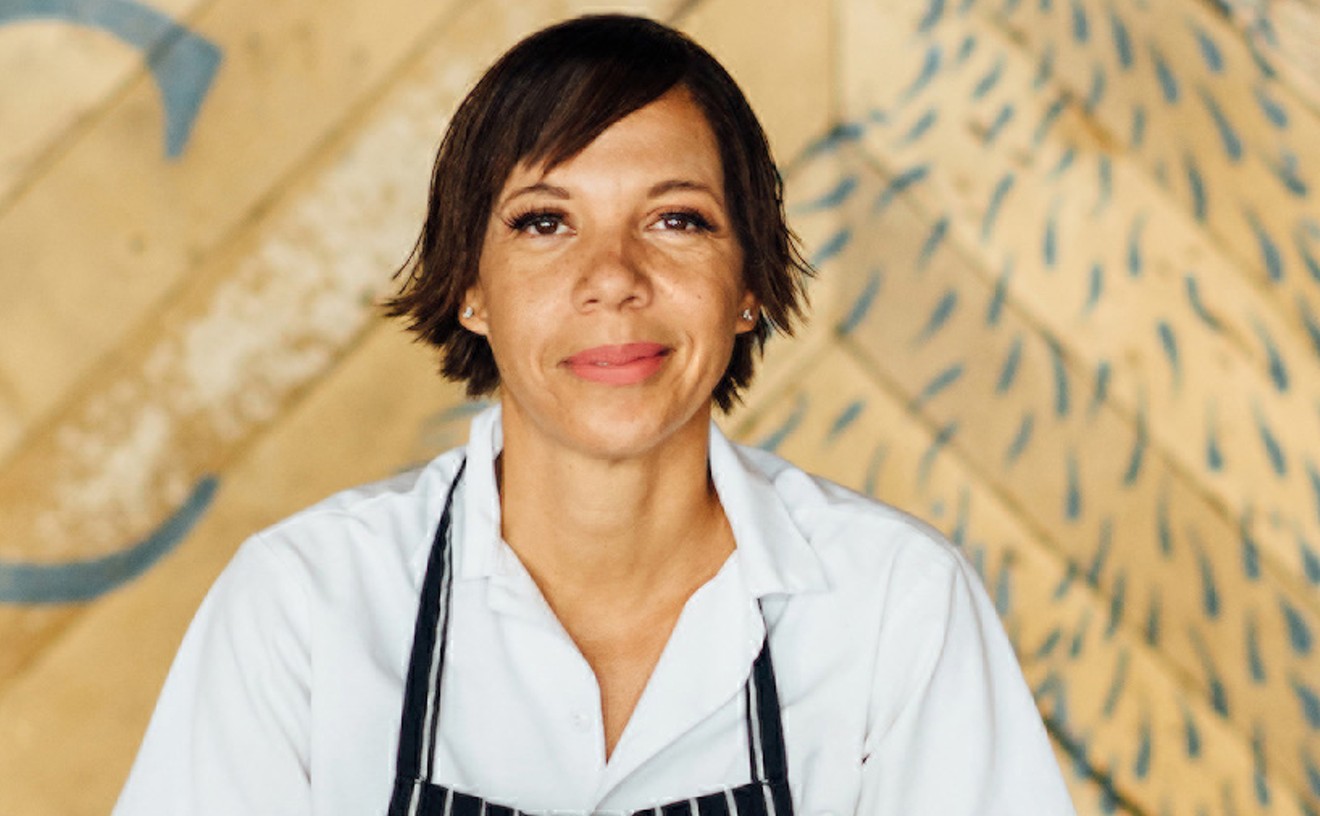The doughy crust is so chewy it almost seems undercooked. A thin char on the bottom lends a crunchy crescendo to each bite. The ruddy tomato sauce is sweet and thick but devoid of the gently spicy aroma of basil and oregano. There's plenty of mozzarella -- Gouda and Parmesan too. But what makes this pizza really unique are toppings like sliced bananas, sticky fried plantains, and delightfully oily picadillo studded with salty green olive rings and sugary raisins.
Pizza cubana might be El Exilio's most unexpected delivery to South Florida. In dozens of small cafeterias, it's a utility meal for the cash-strapped and a quick and flavorful way to cap off a night of drinking.
Cuban pizza isn't the pinnacle of the island's culinary offerings; that distinction belongs to lechón asado. Instead, it is a symbol of the struggle and hardships endured by tens of thousands of families that fled after the 1959 revolution. In the United States, immigrants long ago started pizzerias hoping for a better life and then built them into small empires stretching from Hialeah to Kendall and from Westchester to South Beach.
They couldn't help but make it their own.
No one knows for sure where Cuban pizza was invented. Manuel Montes de Oca, whose family owns five eponymous eateries across Miami, says his father, Manolo, was one of the first to make the dish on the island. He did so in Varadero, a beach town east of Havana, before the revolution. "Tourists would ask where they could go to eat pizza, and he had no reply, so he invented his own," Manuel says.
Ramon Rodriguez Jr., who today owns Rey's Pizza, says his father also made pizza -- in Havana -- well before Castro's revolution in 1959. Ramon Sr. baked inch-thick pies topped with ground chorizo and shrimp in a tangy tomato sauce.
The two families -- the Montes de Ocas and the Rodriguezes -- are the heart of Cuban pizza. Their American journeys seem to have begun in May 1980, when Manolo Montes de Oca loaded his family, including 4-year-old Manuel, onto an overcrowded, 27-foot boat that a relative had shuttled from Miami. After crossing the Florida Straits, the elder Montes de Oca bought a small storefront on Calle Ocho at SW 58th Street adjacent to Rey's Jewelry. He had help from an uncle, who loaned him a little more than $10,000.
Coincidentally, the prior owner, Reynaldo Zamora, had planned for his brother to open a pizzeria there. But when that didn't happen, he sold it to Manolo, who started his pizzeria in 1981. "I had no childhood whatsoever. I would sleep on the counters, on top of the chairs," Manuel says. "From the age of 8 until forever, I would come in and roll the dough by hand."
That dough is what made Cuban pizza stand out, Manuel says. "We use milk, oil, salt, and sugar, a lot of things you find that are used to make Cuban bread."
Ramon Rodriguez Sr. has an even longer history with pizza. He had been imprisoned by the Castro regime for four years beginning in 1968 for economic crimes against the state.
"Before the revolution, he had four successful restaurants, all in Havana," Ramon Jr. says. "Those were taken away from him, and he was told not to open up any more restaurants. When he did, they threw him in jail."
After Castro opened the prisons in 1980, Rodriguez Sr. passed through Miami on his way to Michigan, where he worked as a butcher. He returned to the Magic City in 1985, just as the lease on the original Rey's expired. Rodriguez Sr. partnered with Montes de Oca to open a new Rey's on Flagler Street at NW 24th Avenue.
But the Rey's on Flagler soon foundered. It was barely able to register more than $1,000 in sales a week, Ramon Jr. recalls. "It was a nickel-and-dime kind of operation."
The elder Montes de Oca soon sold his share to Ramon Sr. for $20,000. But the split was only the beginning of the drama. Montes de Oca opened pizza places called "Original Rey's Pizza," and a five-year legal dispute began that ended with Montes de Oca paying a financial penalty and agreeing to use a different name.
The two families don't speak to each other now, but they have more competitive rivalry than animosity.
Today, nine Rey's Pizza restaurants are spread across Miami-Dade County. They serve individual and family-size pies that cost $7 to $17 and are covered with a crumble of bright-red chorizo or thumb-size shrimp cooked in a sweet tomato sauce. "When you bite into it, there's the crunch, the softness of the bread, and the cheese and toppings take it to another level," Ramon Jr. says.
The Montes de Oca empire comprises five restaurants that, like Rey's, have a hefty presence in Hialeah. At Montes de Oca -Original Pizza Cubana, you can get a picadillo pie ($6.75 for a personal and $16.50 for a large) and a pizza that's a patchwork of oval banana slices. "There were no such kinds of toppings when we got here," Manuel says.
Though both families claim the Cuban pizza crown, the one who wears it will be the one who writes the future of this storied dish.
There is plenty more room for creativity atop these pies. The world of Cuban cuisine is stuffed with flavors, textures, and ingredients that would play perfectly on these pillowy crusts. Let's hope the next generation of Cuban pizza royalty puts them there.
Montes de Oca Original Pizza Cubana
Banana pizza $6.75/$16.50
Picadillo pizza $6.75/$16.50
Rey's Pizza
Chorizo pizza $6.85/$16.91
For more follow Zach on Twitter or Instagram.
Follow Short Order on Facebook, on Twitter @Short_Order, and Instagram @ShortOrder.











